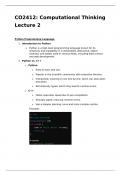Lecture notes
CO2412 Computational Thinking Lecture 2 Notes
- Institution
- University Of Central Lancashire Preston (UClan)
This document contains detailed notes from Lecture 2 of the CO2412 course on Computational Thinking. The lecture provides an introduction to the Python programming language, focusing on its simplicity, readability, and wide usage in fields such as data science and web development. The notes compare...
[Show more]



